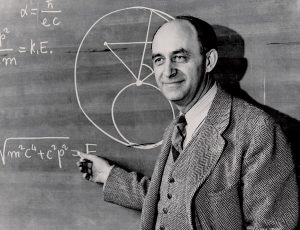 Enrico Fermi ( 29 september 1901 – 28 november 1954) is thought to be one of the " Architects of the Nuclear Age". He was one of the only physicists, who managed to be a brilliant theoretic and practic at the same.
Enrico Fermi ( 29 september 1901 – 28 november 1954) is thought to be one of the " Architects of the Nuclear Age". He was one of the only physicists, who managed to be a brilliant theoretic and practic at the same.
Quite a few patents in the nuclear field are connected to Fermi . In 1938 he was awarded the Nobel prize in physics for his work with radiation created by neutron bombings and for his resounding discovery of transuranic elements. His contributionl to statical mechanics, the quantum theory and nuclear and particle physics was also substantial.
Fermi's first success came in statistical mechanics. After the discovery of the Pauli exclusion principle by Pauli Wolfgang in 1925, Fermi applied it on ideal gasses using statistical formulation. This became known as the Fermi-Dirac statistics..
The particles that arrive from the Pauli principle are now called fermions.Some time later Pauli put forward a hypothesis that there exists an unknown neutral particle, which emits together with electrons during beta fission. Fermi used this idea to formulate his own model of the unknown particle, which he named as neutron. His theory, later named the vastastikmõjuksdescribes one of the four natural fundamental forces.
During his experiments Fermi noticed that slow neutrons are absorbed by atom cores more frequently than fast neutrons and created a formula to describe the phenomenon. After examening the results of thorium and uranium bombardments he came to the conclusion that new elements were created during the process. While he was awarded the Nobel prize for this finding, it was later discovered that the new elements were just the products of fission.
Because of Italian racial laws, he left with his Jewish wife Laura Capon in 1938 to receive the Nobel Prize for Physics in Stockholm, from where he emigrated to the United States. There, during the Second World War, he joined the Manhattan Project.
Fermi led the team that designed and built the first nuclear reactor, Chicago Pile 1, which reached criticality on December 2, 1942, proving for the first time the man-made, self-sustaining nuclear chain reaction. He was involved in the launch of the X-10 graphite reactor at Oak Ridge, Tennessee in November 1943 and the B reactor at Hanford in 1944.
In Los Alamos, he headed the F Division, which worked on the development of the Edward Teller hydrogen bomb. On 16 July 1945, Fermi observed the Trinity experiment, where he used his own method for calculating the bomb's explosive yield, estimating an explosive yield of 10 kilotonnes of trotyl.
After the war, Fermi served on the General Advisory Committee, chaired by J.R. Oppenheimer, which advised the Atomic Energy Commission on nuclear physics. After the detonation of the first Soviet nuclear warhead in August 1949, he strongly opposed the development of the hydrogen bomb on moral and technical grounds.
He was one of the scientists who testified at Oppenheimer's 1954 impeachment trial, which resulted in the suspension of Oppenheimer's secret clearance. Fermi did important work in particle physics, particularly in relation to pions and muons, and hypothesised that cosmic rays were created when particles were accelerated in the magnetic field of interstellar space.
Many prizes and institutions are named after Fermi, including
- Enrico Fermi Award,
- Enrico Fermi Institute,
- Fermi National Acceleration Laboratory (Fermilab),
- Fermi Gamma-ray Space Telescope,
- Enrico Fermi Nuclear Generating Station and synthetic element fermium, one of 16 scientists after whom the chemical element is named.
